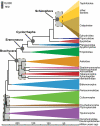Episodic radiations in the fly tree of life
- PMID: 21402926
- PMCID: PMC3078341
- DOI: 10.1073/pnas.1012675108
Episodic radiations in the fly tree of life
Abstract
Flies are one of four superradiations of insects (along with beetles, wasps, and moths) that account for the majority of animal life on Earth. Diptera includes species known for their ubiquity (Musca domestica house fly), their role as pests (Anopheles gambiae malaria mosquito), and their value as model organisms across the biological sciences (Drosophila melanogaster). A resolved phylogeny for flies provides a framework for genomic, developmental, and evolutionary studies by facilitating comparisons across model organisms, yet recent research has suggested that fly relationships have been obscured by multiple episodes of rapid diversification. We provide a phylogenomic estimate of fly relationships based on molecules and morphology from 149 of 157 families, including 30 kb from 14 nuclear loci and complete mitochondrial genomes combined with 371 morphological characters. Multiple analyses show support for traditional groups (Brachycera, Cyclorrhapha, and Schizophora) and corroborate contentious findings, such as the anomalous Deuterophlebiidae as the sister group to all remaining Diptera. Our findings reveal that the closest relatives of the Drosophilidae are highly modified parasites (including the wingless Braulidae) of bees and other insects. Furthermore, we use micro-RNAs to resolve a node with implications for the evolution of embryonic development in Diptera. We demonstrate that flies experienced three episodes of rapid radiation--lower Diptera (220 Ma), lower Brachycera (180 Ma), and Schizophora (65 Ma)--and a number of life history transitions to hematophagy, phytophagy, and parasitism in the history of fly evolution over 260 million y.
Conflict of interest statement
The authors declare no conflict of interest.
Figures



References
-
- Schluter D. The Ecology of Adaptive Radiation. Oxford: Oxford Univ Press; 2000.
-
- Rabosky DL. Ecological limits and diversification rate: Alternative paradigms to explain the variation in species richness among clades and regions. Ecol Lett. 2009;12:735–743. - PubMed
-
- Simpson GG. The Major Features of Evolution. New York: Columbia Univ Press; 1953.
-
- Hennig W. Diptera (Zweiflügler) In: Helmcke J-G, Starck D, Wermuth H, editors. Handbuch der Zoologie. Berlin: De Gruyter; 1973. Band IV, 2 Hälfte: Insecta, 2/31, Lfg. 20.
Publication types
MeSH terms
Substances
LinkOut - more resources
Full Text Sources
Other Literature Sources
Molecular Biology Databases

